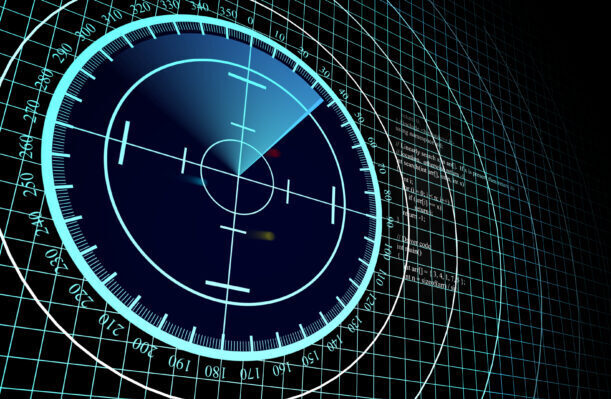

The popular concept of radar can be seen in a hundred movies – a group of serious-looking controllers studies a circular screen intently in a darkened room. They could be civilians or soldiers, but the sweeping radar display is very familiar to most of us.
Radar has become an essential tool in the aerospace, marine and even land-based theaters. The concept behind radar is very simple and the name itself – RADAR – is short for Radio Detection and Ranging. Radio waves are emitted from a source, and when they encounter an object, some of the energy is reflected and collected by a receiver. With some elementary mathematics, it is possible to determine the distance and usually the direction to the object.
The concept of radar was first proposed as far back as the 19th century. However, the first practical radar sets were introduced in the darkening days of the 1930s to detect incoming aircraft. The first sets were cumbersome, with enormous antennae and valve-based electronics. However, the state of the art progressed so rapidly that, by the mid-1940s, radar sets were small and light enough to be mounted aboard aircraft. Since the Second World War, radar technology has been applied in a huge array of applications.
The earliest successes in the field of radar experimentation came in aerospace. The first practical use of radar was in the south-east of England, and the towers of the Chain Home system were over 300 feet tall. Within just a few years, radar receivers were often using dish-shaped receivers that are familiar today.
The Boeing E-7A Wedgetail, the latest in airborne battlespace management.
With the advent of microelectronics, radar sets became lighter and more compact. Now, almost all larger aircraft employ some form of radar for avoiding weather. However, it is in military aircraft that radar has reached possibly its highest level of sophistication. Where once a radar screen would show little more than fuzzy shapes, modern airborne radar is capable of detecting and managing an enormous volume of airspace. Combat aircraft use radar to detect and engage potential targets, while surveillance aircraft use radar to search for and classify surface features as well as air traffic.
Radar has also been hugely successful at sea. Ships offer much larger platforms than aircraft, and modern marine radar sets are used for navigation and safety as well as for surveillance and battlespace control. However, although ships are larger than aircraft, there are still concerns around weight and volume that must be addressed when designing shipborne systems.
HMS Dragon, an air-defense destroyer with high-mounted SAMPSON radar
To obtain the best performance and compensate for the curved surface of the Earth, the majority of radar systems are placed as high as possible. With a shipborne radar mounted as much as 40 meters above the surface of the water, an overly heavy system can be a cause of instability. So therefore, just as in their airborne equivalent, equipment weight is of paramount concern.
Radar has even found its way onto the conventional battlefield. As radar systems have become smaller, it has become practical for radar systems to be vehicle-mounted, and they have been adopted for a number of battlefield roles. The latest innovation in point-defence systems for fighting vehicles is able to detect incoming projectiles and intercept them before impact. The rapid reaction and pinpoint accuracy of these systems depend on the supreme reliability and high performance of the components used in their construction.
Lightweight Counter-Mortar Radar (LCMR) counterfire radar system as used by the U.S. Army
The latest phased array radar systems depend on high-speed computing to process the vast amount of data being collected. In order to provide connectors for these latest systems, Samtec offers a range of products and programs for military and aerospace applications.
The Samtec Military/Aerospace Product (MAP) program delivers a range of solutions for designers in this demand market. From modifying standard Commercial Off-the-Shelf (COTS) products to manufacturing location controls, Samtec can offer connectors that deliver high performance with the quality control required for military applications.
In addition, the Severe Environment Testing (SET) program takes Samtec’s standard range of connectors and tests them far beyond conventional standards for service life, vibration, shock and temperature cycling. In this way, customers can be confident in the performance that Samtec can deliver.
Company expands AI order-taking solution to tackle rising labor costs and improve customer experience Hi…
Outperforming competitors like OpenAI and ElevenLabs across standard datasets and specialized jargon recognition, Jargonic sets…
NVIDIA announced KAI Scheduler, the open-source version of the NVIDIA Run:ai Scheduler, available as a…
Partnership will deliver revolutionary, emissions-free travel in the UK, including greater connectivity for Virgin Atlantic…
New Vicor DCM3717 and DCM3735 DC-DC power modules support the growing trend of 48V-centric power…
DigiKey, a leading global commerce distributor offering the largest selection of technical components and automation…